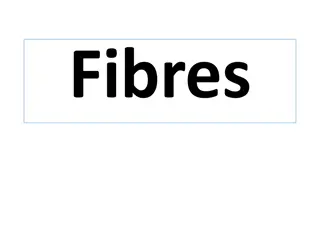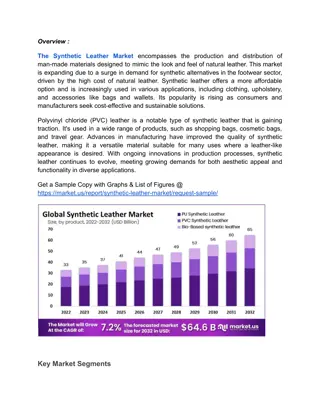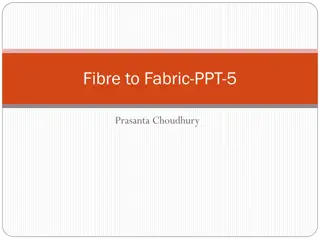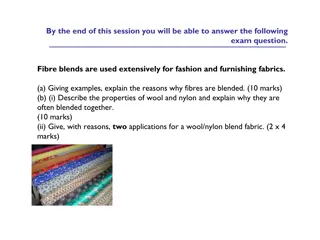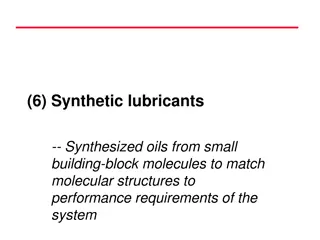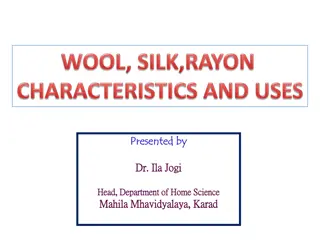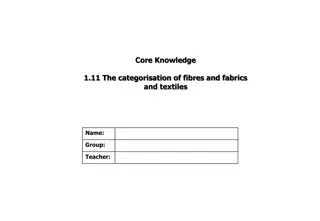Understanding Synthetic Fibres: Advantages, Disadvantages, and Uses
Dive into the world of synthetic fibres, from their production in laboratories using chemicals to their uses and comparisons with natural fibres. Explore the advantages and disadvantages of synthetic fibres such as nylon, polyester, and more. Understand their properties, including wrinkle resistance, water repellency, and colorfastness, while also learning about their limitations in terms of comfort and flammability.
Download Presentation

Please find below an Image/Link to download the presentation.
The content on the website is provided AS IS for your information and personal use only. It may not be sold, licensed, or shared on other websites without obtaining consent from the author. Download presentation by click this link. If you encounter any issues during the download, it is possible that the publisher has removed the file from their server.
E N D
Presentation Transcript
Fibre To Fabric-PPT-8 Prasanta Choudhury
Teaching Points (a) Synthetic Fibres (b) Uses of Synthetic Fibres (c) Advantages of Synthetic Fibres (d) Dis-advantages of Synthetic Fibres
Introduction You know cadets; We cannot increase the production of Natural fibres the way we like. Production of the Natural fibres is Season dependent, type of Soil dependent, Climate dependent etc. To mitigate the growing demand of fibres, we have to find an alternative of Natural fibres. Today, we shall discuss about the Artificial Fibres!
Synthetic Synthetic Fibres Fibres The fibres which are prepared in laboratories using chemicals are known as Synthetic fibres. Synthetic fibres are made from chemicals like Petroleum. e.g. Rayon, Nylon, Acrylic, Polyester etc. Uses: Synthetic fibres like Nylon is very strong. Threads made of Nylon is used in Parachutes and Rock climbing. Synthetic fibres can be dyed very easily. Synthethic fabrics are colourful.
Synthetic Synthetic Fibres Fibres Advantages: Fabrics made from synthetic fibres do not wrinkle. Synthetic fibres are strong. Synthetic fibres do not absorb water. Clothes made from synthetic fibres dry faster. Synthetic fibres are not attacked by insects like moths and other animals. Disadvantages: We do not feel comfortable when we wear synthetic fabrics in summer because they do not absorb sweat. Synthetic fibres burn easily; so we should not wear them while working near a fire.
Synthetic Synthetic fibres fibres Vs Natural Vs Natural fibres fibres: : Synthetic fibres 1. Synthetic fibres are artificially produced. 2. Production of synthetic fibres is unlimited. 3. Synthetic fibres are not attacked by insects like moths and other animals. 4. Synthetic fibres are of low cost and can be dyed in different colours very easily. Natural Fibres 1. Natural fibres are naturally produced. 2. Production of natural fibres is limited. 3. Natural fibres are attacked by insects like moths and other animals. 4. Natural fibres are of high cost and cannot be dyed in different colours very easily.
Some Questions & Answers Question: Define Synthetic fibres. Answer: The fibres which are prepared in laboratories using chemicals are known as Synthetic fibres. Question: Name the raw material used to prepare Synthetic fibres. Answer: The raw material used to make Synthetic fibres is Petroleum. Question: Name the synthetic fibre which is very hard. Answer: Nylon is the synthetic fibre which is very hard.
Some Questions & Answers Question: Mention few advantages of Synthetic fibres. Answer: Fabrics made from synthetic fibres do not wrinkle. Synthetic fibres are strong. Synthetic fibres do not absorb water. Clothes made from synthetic fibres dry faster. Synthetic fibres are not attacked by insects like moths and other animals. Question: Mention few disadvantages of Synthetic fibres. Answer: We do not feel comfortable when we wear synthetic fabrics in summer because they do not absorb sweat. Synthetic fibres burn easily; so we should not wear them while working near a fire.







